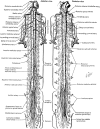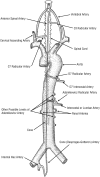Surgical repair following trauma to vascular graft causing spinal cord infarction
- PMID: 24739653
- PMCID: PMC3992606
- DOI: 10.1136/bcr-2013-202283
Surgical repair following trauma to vascular graft causing spinal cord infarction
Abstract
A 55-year-old woman with a background of vascular disease presented with signs of bilateral limb ischaemia. Following elective axillobifemoral bypass and hospital discharge, accidental axillary trauma causing a chest wall haematoma, the patient underwent an emergency graft repair. Postextubation, she reported with absent sensation in her legs. Spinal cord infarction was diagnosed through clinical assessment and exclusion of other causes. The aetiology of compromise to the spinal cord blood supply is unclear. Possibilities include intraoperative hypotension, inadvertent compromise to blood supply of thoracic radicular arteries, dislodged atherosclerotic emboli or a combination of these factors. Spinal cord infarction recognised early can be treated. Sedation to assist ventilation had obscured the problem early enough to consider treatment. Patients with vascular risk factors should be carefully managed intraoperatively to minimise hypotensive episodes and care should also be taken not to compromise blood flow of radicular arteries.
Figures



References
-
- Sandson TA, Friedman JH. Spinal cord infarction. Report of 8 cases and review of the literature. Medicine 1989;68:282–92 - PubMed
-
- Novy J, Carruzzo A, Maeder P, et al. Spinal cord ischemia: clinical and imaging patterns, pathogenesis, and outcomes in 27 patients. Arch Neurol 2006;63:1113–20 - PubMed
-
- Ullery BW, Cheung AT, Fairman RM, et al. Risk factors, outcomes, and clinical manifestations of spinal cord ischemia following thoracic endovascular aortic repair. J Vasc Surg 2011;54:677–84 - PubMed
-
- Goshgarian H. Blood supply of the spinal cord. New York: Demos Medical Publishing, 2003
Publication types
MeSH terms
LinkOut - more resources
Full Text Sources
Other Literature Sources
Medical
